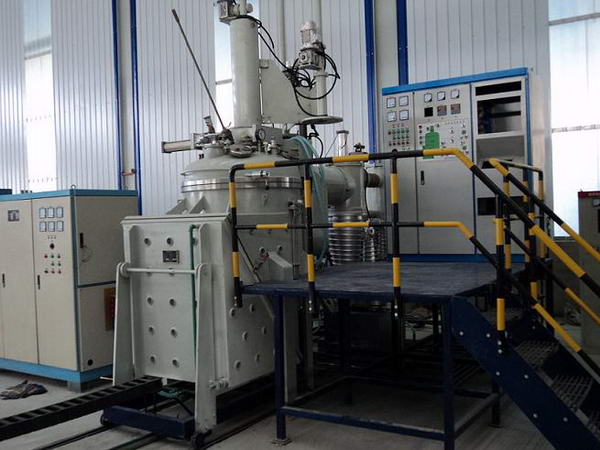vacuum sintering furnace means that powder, powder compact or other forms of material are heated under a vacuum environment at a suitable temperature to achieve interparticle bonding by atomic migration. The purpose of sintering is to make the porous powder compact an alloy having a certain structure and properties.
Advantages of vacuum sintering:
1. Vacuum sintering of vacuum sintering furnace can reduce the pollution of harmful components (water, oxygen, nitrogen and other impurities) in the atmosphere, and avoid a series of reactions such as decarburization, carburization, reduction, oxidation and nitriding. . The vacuum environment is not available in other sintered forms (when the vacuum in the furnace reaches 1.3*10-1 Pascal, the residual gas in the furnace is equivalent to 99.99987% argon);2. Vacuum sintering can completely eliminate the particle oxide film before the liquid phase appears, thereby improving the wettability of the same carbide phase, improving the alloy structure and improving the alloy properties.
3. Due to the decrease of the amount of gas in the pores of the compact in a vacuum environment, the gas product is more easily discharged into the pores and the gas dissolved in the metal is removed, so that the compactness of the material is higher;
4. Vacuum sintering can make the material wear resistance and strength higher;
5. Vacuum sintering also has a significant effect on reducing product costs;

Use of vacuum sintering furnace:
Vacuum sintering furnace is mainly used for sintering of powder metallurgy products, metal injection molding products, stainless steel base, hard alloy, super alloy, high specific gravity alloy, ceramic material, magnetic material, neodymium iron boron and the like.Classification of vacuum sintering furnace
There are two main types of vacuum furnaces:The first type is divided into ordinary sintering furnace (1300 ° C and below), medium temperature sintering furnace (1300 ° C ~ 1600 ° C), high temperature sintering furnace (1600 ° C ~ 2400 ° C).
The second type is divided by the degree of vacuum, which can be divided into low vacuum, high vacuum and ultra high vacuum sintering furnace.
How to buy a vacuum furnace:
1. Selection of vacuum furnace installation methods: Vacuum furnaces are divided into horizontal and vertical furnaces. Vertical furnaces are divided into upper discharge and lower discharge structures. The choice is based on the type, shape or placement of the product that is primarily sintered.2. Selection of heating components: The heat transfer mode of the heating element of the vacuum furnace to the workpiece is different from that of the ordinary electric heating furnace, and the radiation heat transfer is the main. The heating components of the vacuum sintering furnace mainly include nickel-chromium, high-temperature molybdenum, graphite and graphite strips (plates), tungsten strips and tungsten mesh. Nickel-chromium is mainly used in vacuum furnaces with temperatures below 1000 °C. High-temperature molybdenum can be used in vacuum furnaces below 1600 °C. Graphite and graphite strips (plates) can be used in vacuum furnaces below 2300 °C. Tungsten strips and tungsten mesh can be used in 2400. Vacuum furnace below °C. The choice of heating components is primarily determined by the sintering temperature, the physical and chemical properties of the product.
3. Selection of heat shield: The heat shield is the main component of the vacuum sintering furnace heating chamber. Its main function is heat insulation, heat preservation and heat loss reduction. It is also the structural basis of the fixed heater. Therefore, the choice of the structure and materials of the heat shield has a great influence on the power and performance of the vacuum furnace (such as vacuum degree, gas release rate, etc.). The heat shield is basically divided into two types: metal heat shield and non-metal heat shield. Its structural form is divided into all-metal heat shield, sandwich heat shield, graphite felt heat shield and hybrid felt heat shield. The choice of heat shield is determined primarily by the sintering temperature, the physical and chemical properties of the product, and the vacuum requirements.
4. Selection of vacuum system: The vacuum configuration has the following types. The first one is a low vacuum configuration, configured as a mechanical pump (rotary vane pump or slide valve pump), the ultimate vacuum degree is up to about 10 Pa; the second is medium vacuum Configuration, configuration Roots pump and mechanical pump (rotary vane pump or spool valve pump) combination, the ultimate vacuum can reach 2 * 10-1 Pa; the third is high vacuum configuration, generally configured as diffusion pump + Roots pump + Mechanical pump (rotary vane pump or slide valve pump), the ultimate vacuum can reach 2*10-3 Pa; the fourth is turbomolecular pump + Roots pump + mechanical pump (rotary vane pump or spool valve pump), ultimate vacuum The degree can reach 2*10-4 Pa. The choice of vacuum system is primarily based on the working vacuum.
5. Selection of cooling system: The cooling mode of vacuum furnace can be divided into natural cooling and forced cooling. The forced cooling is divided into internal circulation cooling and external circulation cooling. The aeration medium is typically high purity nitrogen or argon.















